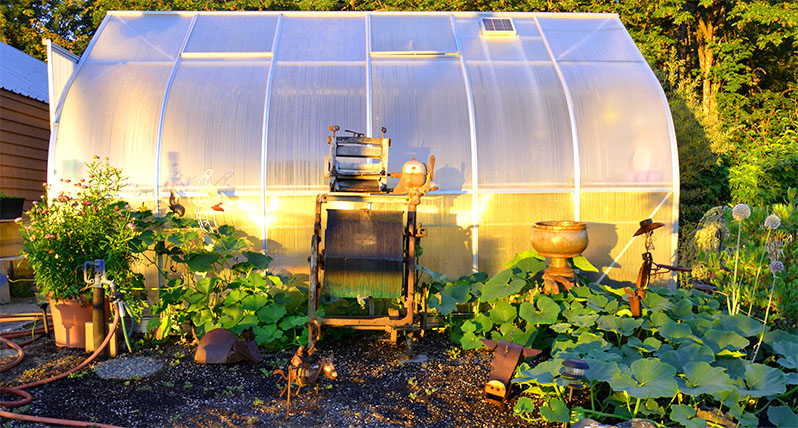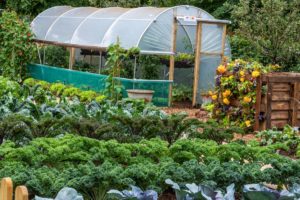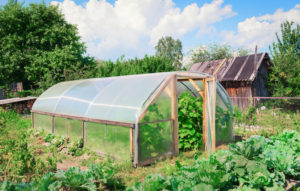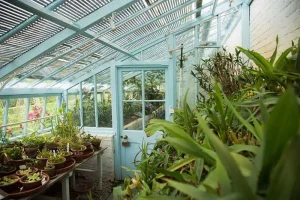As the seasons change and the days grow shorter, many gardeners find themselves facing a challenge – how to continue growing their favorite crops and enjoying fresh produce well into the autumn months.
Fortunately, with a little creativity and some innovative techniques, it’s possible to extend your growing season and enjoy a bountiful harvest for longer than you might think!
From using row covers to protect young seedlings from frost to employing hydroponic systems to grow delicate greens year-round, there are plenty of strategies that can help you get the most out of your garden.
Let’s dive into some innovative ways to extend your growing season and keep your harvest thriving all fall long!
Use row covers
Row covers are lightweight, porous fabrics that allow plants to breathe and receive sunlight while protecting them from extreme temperatures, frost, and pests. By using row covers, you can extend the growing season by a few weeks or even months, depending on the climate.
These lightweight, porous fabrics allow plants to breathe and receive sunlight while protecting them from extreme temperatures, frost, and pests.
By covering your plants with a row cover, you can shield them from harsh weather conditions and keep them safe from harm.
Whether you’re trying to protect your plants from an early frost or a late freeze, or you need to keep them safe from insects and diseases, row covers are the perfect solution.
Not only do row covers provide protection, but they also allow your plants to receive the sunlight they need to grow and thrive.
The porous nature of the fabric allows for air and light to pass through, so your plants can still photosynthesize and grow stronger.
In fact, row covers can even help to improve the yield of your crops by allowing them to mature more quickly and evenly.
In addition to protecting your plants, row covers can also help to reduce weed growth and prevent soil erosion.
By blocking out weeds and retaining soil moisture, row covers can help to keep your garden healthy and well-maintained.
Plus, they’re easy to use and can be removed or adjusted as needed, making them a versatile and convenient tool for any gardener.
Whether you’re just starting out or you’re a seasoned pro, row covers are a valuable addition to your gardening arsenal.
Install a hoop house or high tunnel
Hoop houses and high tunnels are structures made of metal or plastic hoops and polyethylene or polypropylene coverings. These structures can be built over existing beds or raised beds, providing a warmer and more protected environment for plants to grow.
Installing a hoop house or high tunnel can provide your garden with a warmer and more protected environment for plants to grow.
These structures, made of metal or plastic hoops and polyethylene or polypropylene coverings, can be built over existing beds or raised beds, providing an extended growing season for vegetables, fruits, and flowers.
The protective coverings of hoop houses and high tunnels help to shield plants from harsh weather conditions such as wind, hail, and frost, which can damage or kill crops.
The warmer and more stable environment within the structure promotes healthy growth and productivity, allowing you to grow a wider variety of crops and harvest them earlier in the season.
By installing a hoop house or high tunnel, you can lengthen the growing season, increase crop yields, and enjoy a more productive and profitable garden.
Use a cold frame
A cold frame is a small, enclosed structure made of wood or metal that covers a bed or container. The cold frame uses transparent materials to let in sunlight and trap heat, providing a protected environment for plants to grow.
Using a cold frame is an excellent way to extend the growing season and protect your plants from harsh weather conditions.
This small, enclosed structure is typically made of wood or metal and covers a bed or container, providing a protected environment for your plants to grow.
The transparent materials used in the cold frame allow sunlight to enter, while trapping heat and retaining moisture, creating a microclimate that is ideal for plant growth.
By using a cold frame, you can plant and grow a variety of vegetables, herbs, and flowers early in the season, before the last frost date.
This will give you a head start on the growing season, allowing you to harvest crops sooner and enjoy a longer period of garden productivity.
The protected environment of the cold frame will help to protect your plants from extreme weather conditions, such as high winds and heavy precipitation, ensuring that they remain healthy and thrive.
To set up a cold frame, you will need to construct the frame using wooden or metal parts, and then cover it with a transparent material such as glass or plastic.
Make sure to provide adequate ventilation and drainage to prevent overheating and waterlogged soil.
You can also add a hinged or removable top to the cold frame, allowing you to easily access your plants and maintain the environment inside.
With proper care and maintenance, a cold frame can provide a productive and protected environment for your plants to grow all year round.
Start seeds indoors
By starting seeds indoors, you can get a head start on the growing season and transplant seedlings outside when the weather warms up. This can be especially useful for plants that are sensitive to frost or have a long growth cycle.
Starting seeds indoors is a great way to get a head start on the growing season and ensure a successful harvest.
By planting seeds indoors, you can take advantage of the warmer and more controlled environment, which can be especially useful for plants that are sensitive to frost or have a long growth cycle.
This method allows you to bypass the threat of frost and cold weather, which can be detrimental to certain plants.
Starting seeds indoors gives you the opportunity to carefully monitor and control the conditions, such as temperature, light, and water, to create an optimal environment for germination and growth.
By transplanting seedlings outside when the weather warms up, you can ensure a successful transition to the outdoors and maximize your yield.
Use a hot bed
A hot bed is a raised bed or container that is covered with a clear plastic dome or sheeting to trap heat and extend the growing season. The heat generated by the plastic can be used to warm up the soil and germinate seeds.
Using a hot bed is an excellent way to extend the growing season and warm up the soil for seed germination.
A hot bed is essentially a raised bed or container covered with a clear plastic dome or sheeting, which traps heat and creates a warm, protected environment for plants to grow.
The plastic dome or sheeting absorbs sunlight during the day and traps the heat, creating a warm microclimate within the bed.
This warmth can be used to warm up the soil and germinate seeds, allowing for an earlier start to the growing season.
To set up a hot bed, simply construct a raised bed or container using materials such as wood or plastic, and cover it with a clear plastic dome or sheeting.
Make sure to secure the plastic tightly around the edges to prevent heat from escaping.
You can also add a layer of insulation, such as straw or shredded paper, under the plastic to further enhance the warmth.
Once the hot bed is set up, you can plant your seeds and place the bed in a sunny location.
The heat generated by the plastic will warm the soil and provide a ideal environment for seed germination.
As the plants grow, the hot bed can be used to extend the growing season and provide a head start on the weather.
Overall, using a hot bed is a simple and effective way to extend the growing season and warm up the soil for seed germination.
With a little preparation and attention, you can create a productive and successful garden, even in cooler climates.
Build a passive solar greenhouse
A passive solar greenhouse is a structure that uses natural sunlight and heat to grow plants. The design of the greenhouse is based on the principles of passive solar design, which allows for natural heating and cooling of the space.
Building a passive solar greenhouse is a highly effective and sustainable way to grow plants, using natural sunlight and heat instead of artificial lighting and heating systems.
The key to a successful passive solar greenhouse design is to maximize the use of natural sunlight and heat, while minimizing the use of artificial inputs.
To start, consider the orientation of the greenhouse.
The ideal orientation is true south, so that the greenhouse receives direct sunlight for as much of the day as possible.
Next, use materials with high thermal mass, such as concrete or brick, to absorb and store heat during the day, and release it at night.
This can be achieved through the use of thick walls, a high-pitched roof, and ample insulation.
Other key design elements include the use of double-glazed windows and skylights to allow for maximum light penetration, and the use of shading devices such as overhangs or louvers to control the amount of sunlight entering the greenhouse.
In addition, consider the use of passive ventilation systems, such as windows or vents, to allow for air circulation and temperature control.
By carefully designing and building a passive solar greenhouse, you can create a highly efficient and sustainable growing space that requires minimal inputs and outputs.
With proper maintenance and care, a passive solar greenhouse can provide a bountiful harvest of fresh, healthy produce for years to come.
Use a geodesic dome greenhouse
A geodesic dome greenhouse is a lightweight, dome-shaped structure made of metal or plastic that is designed to maximize space and minimize materials. The dome shape provides excellent ventilation and light distribution, making it an ideal solution for extending the growing season.
Using a geodesic dome greenhouse for your gardening needs is an excellent decision for several reasons.
First and foremost, the dome shape provides ideal ventilation and light distribution, ensuring that your plants receive the right amount of air and sunlight.
This leads to healthier and more productive plants, and extends the growing season by up to several months.
The lightweight and durable materials used in the construction of geodesic dome greenhouses make them extremely versatile and easy to assemble, making them a perfect choice for both seasoned gardeners and beginners alike.
With its unique design, the geodesic dome greenhouse also offers a significant reduction in materials and resources, making it an environmentally-friendly and sustainable option.
Overall, investing in a geodesic dome greenhouse will provide you with a reliable and efficient way to cultivate a variety of plants all year round, regardless of the season or climate.
Grow in a shaded location
Growing plants in a shaded location can help extend the growing season by reducing the amount of heat stress the plants experience. This can be especially useful for plants that are sensitive to high temperatures. By growing in a shaded location, you can give your plants a head start on the growing season and reduce the risk of heat stress.
When looking to extend your growing season and reduce heat stress on your plants, consider growing them in a shaded location.
This simple yet effective technique can make all the difference for plants that are sensitive to high temperatures.
By growing in a shaded location, you can give your plants a head start on the growing season and reduce the risk of heat stress.
This is especially useful for plants that thrive in cooler temperatures and cannot tolerate direct sunlight.
Shaded locations can include areas under trees, on the north side of buildings, or in areas with natural shading from walls or other structures.
In addition to protecting plants from direct sunlight, shaded areas can also help to maintain a more consistent temperature, which can be beneficial for plants that are sensitive to extreme heat or cold.
When selecting plants for shaded areas, choose varieties that are specifically bred for shade tolerance.
These plants will be more likely to thrive in lower light conditions and may offer additional benefits such as drought tolerance or increased disease resistance.
Some examples of shade-tolerant plants include impatiens, ferns, and hostas.
By growing your plants in a shaded location, you can help to ensure a longer and more successful growing season, while also providing a more comfortable environment for your plants.
So, consider this simple yet effective technique to extend your growing season and protect your plants from the harsh effects of direct sunlight.
Want More? Dive Deeper Here!
Hey there! If you’re the type who loves going down the rabbit hole of information (like we do), you’re in the right spot. We’ve pulled together some cool reads and resources that dive a bit deeper into the stuff we chat about on our site. Whether you’re just killing time or super into the topic, these picks might just be what you’re looking for. Happy reading!
- Extending the Garden Season with High Tunnels
- Extending the growing season: start early, end later | UMN Extension
- Low Tunnels For Beginners | Extension | West Virginia University
- Plastic Culture to Extend Growing Season | Snohomish County | Washington State University
- Starting a Garden: Season Extension | Illinois Extension | UIUC






